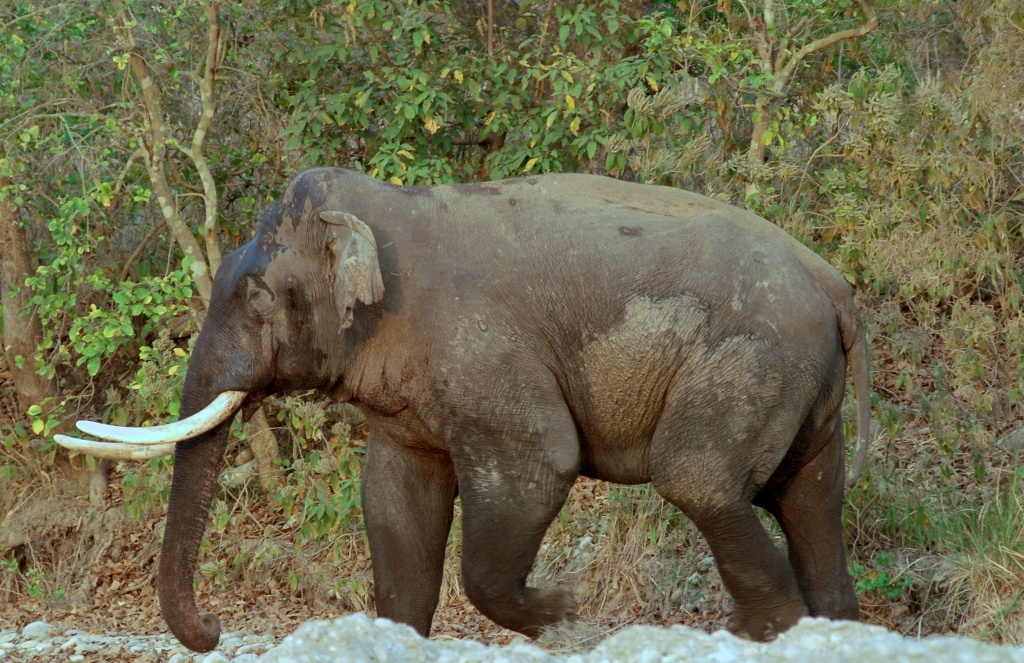
December, 2004, Ghasiram Sot, Chilla Range, Rajaji National Park. The mixed Sal forests along the foothills of the Himalayas were quiet. The nomadic Gujjar pastoralists who had occupied these forests had vacated as part of a voluntary resettlement program, and there was lush Saccharum spontaneum grass in the once heavily overgrazed dry river beds. Emerging from the tall grass, I came face to face with a magnificent tusker. Surprisingly, he did not react, but stood tall, calm and composed, his thick, upwardly curved tusks gleaming in the afternoon sun. Giving the magnificent giant his due respect, I retreated to a safe distance, taking pictures all the while. He was in musth, and there was heavy discharge from his temporal glands. Like most big bulls, he had a broken tail, which was probably bitten off by another male during a fight. This first encounter with ‘Ghasiram Tusker’ (‘GT’ from now on) rewarded me with some memorable pictures.
That winter, GT was very active in Chilla, and we bumped into each other several times during the course of my field work. One evening, as I was setting up a camera trap on a hill road, I heard my driver shouting loudly, and saw him running down the hill. Turning around, I saw GT watching quietly, from just 20 m away. Just to be safe, I grabbed the camera trap and scrambled up the ridge. After a brief pause, GT moved towards our jeep. My tension grew with every step he took, as my expensive photography equipment was lying around in the open vehicle. To create a distraction, I threw a small stone in his direction. Taken by surprise, he panicked, lifted his broken tail and bolted like a scared rat in the direction he had come from!
In the summer of 2005, I had another interesting close encounter with GT. This time he was vigorously shaking a Cordia dichotoma tree near Khara chowki of Chilla range. Elephants are known to feed on Cordia fruits; but with the fruiting season over, there were none left in the tree. After 10 minutes of hard work, he managed to push the tree to an angle, and then pressed it down further with his forelegs. Finally I understood what he was after! A small Ficus bengalensis that was growing in the crown of the Cordia tree! He chewed it with relish, as though it were sugarcane, and left after a while. A huge tree demolished for such a small morsel!
My visits to Rajaji became infrequent after I shifted my base to Kathmandu, and I lost track of GT. And then, after a gap of four years years, in the summer of 2009, we were face to face again. I was walking briskly back to camp after climbing down Goral Ridge when, right in front of the Dholkhand machan, GT was splashing in the water. He had crossed over to West Rajaji from the Chilla forests, through the Chilla-Motichur corridor, and was now here in Dholkhand. He was in musth and looked in great shape. He allowed me another, memorable half hour photo session, as he drank water, and splashed it all over his body. As with our past encounters, he then quietly walked away, and I haven’t seen him since. If you’ve photographed him anytime after the summer of 2009, please email me your photos along with the date and location, to bivash.pandav@wii.gov.in

 CI is a non-profit, non-commercial portal that aims to facilitate wildlife and nature conservation by providing reliable information and the tools needed to campaign effectively.
CI is a non-profit, non-commercial portal that aims to facilitate wildlife and nature conservation by providing reliable information and the tools needed to campaign effectively.
Chosen as 'Picture of the Week'
Bivash Pandav last saw this magnificent tusker at Rajaji National Park in Uttarakhand in 2009. If you've photographed this elephant since then, please send the photo with the date and precise location to bivash.pandav@wii.gov.in.